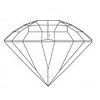14.8: Imitación de piedras preciosas
( \newcommand{\kernel}{\mathrm{null}\,}\)
Imitación de piedras preciosas
Las piedras preciosas de imitación simplemente imitan el color o aspecto de una piedra natural. Se pueden hacer de cualquier cosa. Una circonita cúbica es un diamante de imitación, por ejemplo. Un trozo de vidrio azul podría ser un zafiro de imitación. Una variedad de forsterita sintética azul es una excelente imitación para la tanzanita, mientras que químicamente, su composición está mucho más cerca del peridoto verde amarillento. Otro ejemplo clásico es la “alejandrita” ambientada en muchas piezas de joyería es en realidad una variedad de zafiro sintético de color vanadio.


